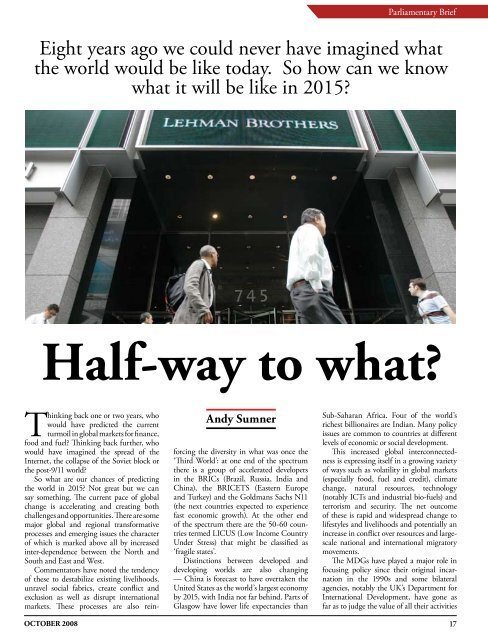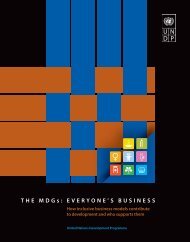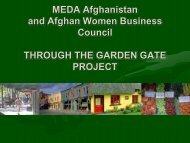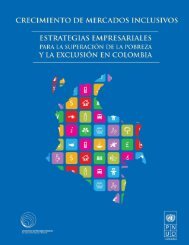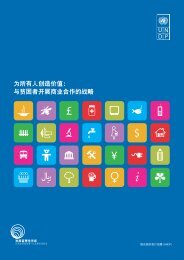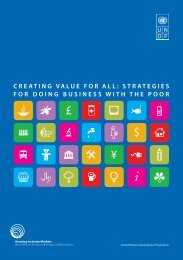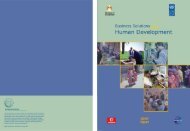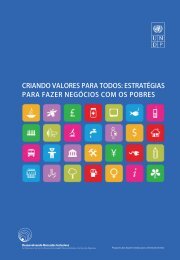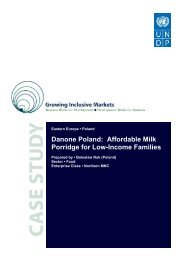Parliamentary BriefDevelopment could bemuch more effectiveif we started <strong>to</strong> thinkoutside of <strong>the</strong> boxCurrent approaches <strong>to</strong> effective aidassume that we are in control andthat change is predictable. Nei<strong>the</strong>ris true, but such assumptions are blockingdonors from responding effectively <strong>to</strong> alargely unpredictable and dynamic policyenvironment. New ways of thinking aboutaid are now needed <strong>to</strong> make it more effective.International aid agencies have got stuckon a treadmill of a certain way of thinkingwhere <strong>the</strong> emphasis is on technical mechanismsof resources and architecture. A solefocus on <strong>the</strong>se may render invisible possibleand useful approaches that, if recognised,could be nurtured and streng<strong>the</strong>ned.Addressing power as central <strong>to</strong> aidrelationships allows for serious critical examinationof <strong>the</strong> organisational cultures andpractices that shape expectations of whatinternational aid can and should do. Relationalpower produces perverse consequencesin which <strong>the</strong> orthodox perspective confirmspreviously-held convictions.Evidence is sought <strong>to</strong> check that one isstill on track, not <strong>to</strong> ask whe<strong>the</strong>r <strong>the</strong>re areo<strong>the</strong>r tracks. Alternative ways of understandingand tackling problems are ignored ordismissed as irrelevant. The choice of indica<strong>to</strong>rsis <strong>to</strong>o often assumed <strong>to</strong> be just a technicalmatter. Power influences whose ideas countand what is deemed a ‘result’.Once this is recognised, opportunitiescan be opened up for dialogue and learning;aid becomes more effective once donorslook for and appreciate diverse perspectives.Governments and multilateral organisationscan improve <strong>the</strong> success of <strong>the</strong>ir aid relationshipsthrough adaptive learning, recognisingdiverse realities experienced by o<strong>the</strong>rs and <strong>the</strong>existence of political relationships in whichinternational aid is embedded.Aid can be more effective if fac<strong>to</strong>rs suchas trust and relationships that recognise andaddress issues of power are taken in<strong>to</strong> accountRosalind Eyben— in addition <strong>to</strong> <strong>the</strong> technical. For example,according <strong>to</strong> a UN official cited in a recentpaper, many of her agency’s most effectivecountry level interventions are those thathave not been reported because <strong>the</strong>se wereconcerned with investing in relationshipsra<strong>the</strong>r than achieving <strong>the</strong> kind of outcomesthat get included in logical frameworks.Perhaps aid is only as effective as it isbecause of what is <strong>to</strong>day not going reported.How many opportunities are we missing formaking aid work better?Donors need <strong>to</strong> think about how power isoperating in everyday practice. For example,even in an international aid conference, <strong>the</strong>way in which <strong>the</strong> conference is designed, howdiversity is recognised and responded <strong>to</strong> and<strong>the</strong> processes that can generate exclusion in<strong>the</strong> room unless specifically addressed. Suchcritical reflection costs nothing and can start<strong>to</strong>morrow.The following four steps do not requireany additional resources or re-arrangementsof development’s institutional architecture.These are simple low cost steps <strong>to</strong> more effectiveaid.1. Donors need <strong>to</strong> learn more about <strong>the</strong>particular context in which <strong>the</strong>y are working.What works in one place, may not work inano<strong>the</strong>r or even in <strong>the</strong> same place at a differentmoment in his<strong>to</strong>ry or with a differentgroup of donors. Such learning is becominga practical challenge for many donor staff,whose time is spent in donor co-ordinationmeetings or in reporting <strong>to</strong> <strong>the</strong>ir ownmanagement. Staff and <strong>the</strong>ir governmentcounterparts need <strong>to</strong> re-organise <strong>the</strong>ir time <strong>to</strong>get out of <strong>the</strong> capital city and listen <strong>to</strong> whatpeople tell <strong>the</strong>m.2. Diverse perspectives need <strong>to</strong> be builtin<strong>to</strong> methodologies for defining and assessing<strong>the</strong> success of aid. While <strong>the</strong>re are someobvious arguments for better co-ordinationand more efficient use of resources, a balancehas <strong>to</strong> be struck between this and encouragingdiverse points of view for solving complexproblems.Both consensus and contestation aredrivers of pro-poor change. If <strong>the</strong> formerdominates, <strong>the</strong>re may be a tendency <strong>to</strong> lookonly for a single diagnosis and solution, thusshutting out <strong>the</strong> possibilities of creative dialogueand <strong>the</strong> collaborative challenging ofimplicit assumptions about how <strong>the</strong> worldworks that hampers innovation and constrainsimagination.3. In addition <strong>to</strong> measuring results,donors need <strong>to</strong> assess <strong>the</strong> quality of relationsat project/programme, country and internationallevels against indica<strong>to</strong>rs agreed withpartners that could be regularly reviewedand widely commented upon. Because anemphasis on performance measurement canlead <strong>to</strong> mutual risk-adverse behaviour, compensa<strong>to</strong>ryprocess indica<strong>to</strong>rs might include‘preparedness <strong>to</strong> take risks’, ‘embracing andlearning from failure’ and ‘willingness <strong>to</strong>change one’s mind’.Such assessments could be supportedby country specific studies <strong>to</strong> bring <strong>to</strong> light<strong>the</strong> way relationships are managed and <strong>the</strong>lessons that can be learnt. Such studies willmake visible processes that may be reinforcingexisting power relations and thushindering <strong>the</strong> effectiveness of aid resourcesand instruments.4. Aid agencies need <strong>to</strong> develop <strong>the</strong>competences of staff in organisational andpersonal self-awareness, <strong>to</strong> develop soundunderstanding of <strong>the</strong> power, position andbiases <strong>the</strong>y hold in relation <strong>to</strong> o<strong>the</strong>rs. Powerhas an adverse effect when we impose ourown point of view. Alternative ways of understandingand tackling problems are ignoredor dismissed as irrelevant; those putting <strong>the</strong>mforward feel disempowered and will drop ou<strong>to</strong>f <strong>the</strong> conversation. Organisational and individualcritical self-reflection delivers benefitsfor donors as well as <strong>the</strong> o<strong>the</strong>rs <strong>the</strong>y seek <strong>to</strong>help. Like <strong>the</strong>m, donors also will learn andthink differently, <strong>to</strong> imagine new possibilitiesand <strong>to</strong> debate alternative choices.Rosalind Eyben has been a Fellow at <strong>the</strong> UKInstitute of Development Studies since 2002,after a long and varied career as an international aid practitioner and policy analyst,including serving as <strong>the</strong> first Chief Social Development Adviser for <strong>the</strong> UK’s Department forInternational Development. She has authored a number of publications on <strong>the</strong> internationalaid system including Relationships for Aid published by Earthscan in 2006.16OCTOBER 2008
Parliamentary BriefEight years ago we could never have imagined what<strong>the</strong> world would be like <strong>to</strong>day. So how can we knowwhat it will be like in 2015?Half-way <strong>to</strong> what?Andy SumnerThinking back one or two years, whowould have predicted <strong>the</strong> currentturmoil in global markets for finance,food and fuel? Thinking back fur<strong>the</strong>r, whowould have imagined <strong>the</strong> spread of <strong>the</strong>Internet, <strong>the</strong> collapse of <strong>the</strong> Soviet block or<strong>the</strong> post-9/11 world?So what are our chances of predicting<strong>the</strong> world in 2015? Not great but we cansay something. The current pace of globalchange is accelerating and creating bothchallenges and opportunities. There are somemajor global and regional transformativeprocesses and emerging issues <strong>the</strong> characterof which is marked above all by increasedinter-dependence between <strong>the</strong> North andSouth and East and West.Commenta<strong>to</strong>rs have noted <strong>the</strong> tendencyof <strong>the</strong>se <strong>to</strong> destabilize existing livelihoods,unravel social fabrics, create conflict andexclusion as well as disrupt internationalmarkets. These processes are also reinforcing<strong>the</strong> diversity in what was once <strong>the</strong>‘Third World’: at one end of <strong>the</strong> spectrum<strong>the</strong>re is a group of accelerated developersin <strong>the</strong> BRICs (Brazil, Russia, India andChina), <strong>the</strong> BRICETS (Eastern Europeand Turkey) and <strong>the</strong> Goldmans Sachs N11(<strong>the</strong> next countries expected <strong>to</strong> experiencefast economic growth). At <strong>the</strong> o<strong>the</strong>r endof <strong>the</strong> spectrum <strong>the</strong>re are <strong>the</strong> 50-60 countriestermed LICUS (Low Income CountryUnder Stress) that might be classified as‘fragile states’.Distinctions between developed anddeveloping worlds are also changing— China is forecast <strong>to</strong> have overtaken <strong>the</strong>United States as <strong>the</strong> world’s largest economyby 2015, with India not far behind. Parts ofGlasgow have lower life expectancies thanSub-Saharan Africa. Four of <strong>the</strong> world’srichest billionaires are Indian. Many policyissues are common <strong>to</strong> countries at differentlevels of economic or social development.This increased global interconnectednessis expressing itself in a growing varietyof ways such as volatility in global markets(especially food, fuel and credit), climatechange, natural resources, technology(notably ICTs and industrial bio-fuels) andterrorism and security. The net outcomeof <strong>the</strong>se is rapid and widespread change <strong>to</strong>lifestyles and livelihoods and potentially anincrease in conflict over resources and largescalenational and international migra<strong>to</strong>rymovements.The MDGs have played a major role infocusing policy since <strong>the</strong>ir original incarnationin <strong>the</strong> 1990s and some bilateralagencies, notably <strong>the</strong> UK’s Department forInternational Development, have gone asfar as <strong>to</strong> judge <strong>the</strong> value of all <strong>the</strong>ir activitiesOCTOBER 2008 17


